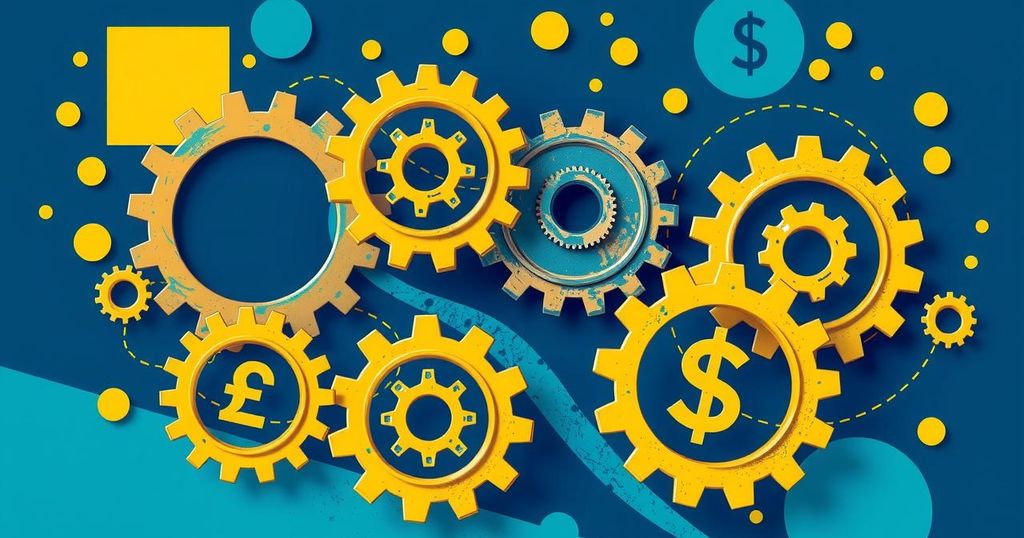Inside Central Bank’s High-Stakes Battle for Stability

Nigeria is experiencing an economic transformation initiated by the Central Bank under Governor Olayemi Cardoso. His tenure marks a shift to orthodox monetary policies amid sky-high inflation and a depreciating currency. The bank’s aggressive maneuvers, including raising interest rates and the Cash Reserve Ratio, are seen as necessary but painful measures to restore stability. Structural reforms alongside these financial policies are crucial for sustainable economic improvement in the future.
In a bold move for its economy, Nigeria finds itself navigating a complex landscape of reform, spearheaded by the Central Bank, which has taken significant steps under the leadership of Governor Olayemi Cardoso, appointed in September 2023. The bank’s approach has seen a decisive pivot from expansive, development-focused monetary strategies of the past, toward stricter orthodox monetary policies. This shift isn’t happening in a vacuum; Nigeria faces intense economic pressures including rampant inflation, a devalued currency, and systemic issues requiring immediate attention.
After almost a decade of interventionist monetary tactics under former governor Godwin Emefiele, the bank’s new direction is clear. Cardoso stated, “Monetary policy is necessary but not sufficient,” indicating a forthcoming phase characterized by tighter money supply and increased transparency. This was made evident as just months into his tenure, the Monetary Policy Rate jumped from 18.75 percent to 24.75 percent, a steep increase designed to combat inflation which hit a staggering 33.69 percent in April 2024, the highest in thirty years. Alongside this, the Cash Reserve Ratio was elevated to 45 percent — one of the top rates globally.
The inflation crisis is fueled by a trio of interlinked challenges: ongoing violence in agricultural regions, the phasing out of expensive fuel subsidies, and intense fluctuations in the exchange rate. Food production has suffered due to insecurity in the North-East and North-Central regions, leading to food inflation levels at 40.53 percent. Economists are scrutinizing the repercussions of subsidy removal in May 2023, which has seen transportation costs leap by as much as 70 percent.
Perhaps the most significant change occurred with the unification of Nigeria’s multiple exchange rate windows last June. This reform, which was long overdue, saw the naira, Nigeria’s currency, drop sharply from N460 to over N1,300 per dollar; reports indicate it now hovers at approximately N1,638 per dollar. The CBN has also stepped back from being the primary foreign exchange supplier, allowing market forces to dictate prices more directly. While this upended the financial landscape initially, signs of stabilization are beginning to surface with foreign investors cautiously re-entering the market, tempted by interest-paying government securities.
Cardoso has pushed for more transparent communications and regular data-sharing since taking the reins, showcasing an unprecedented level of clarity not usually seen in the bank’s previous operations. The evolution of the Central Bank’s communication has included richer, data-driven quarterly Monetary Policy Committee meetings, paired with media briefings, aimed at overcoming the scattered signals that have muddied public understanding in the past.
Moreover, the bank’s collaboration with fiscal authorities has markedly improved, focusing on aligning monetary tightenings and fiscal reforms to mitigate budget deficits and cultivate foreign investment. Nonetheless, Cardoso is wary. He told reporters, “Monetary policy alone cannot resolve inflation driven by structural issues.” Some economists, such as Professor Pat Utomi, concur, emphasizing that interest rate hikes without broader reforms might merely treat symptoms rather than the underlying cause.
To bolster banking stability, the CBN rolled out a major recapitalization plan in January 2024, mandating Tier 1 banks to raise their minimum capital to N500 billion, while Tier 2 banks must reach N200 billion. This restructuring aims to fortify Nigerian banks against unexpected shocks and enhance their competitive edge on the global stage. Additionally, efforts to regulate Nigeria’s burgeoning fintech scene have ramped up, introducing more stringent customer verification processes and real-time monitoring protocols to mitigate systemic risks.
Initial outcomes from these sweeping changes are mixed. There have been successes, such as improving policy credibility and reducing long-standing economic distortions. A significant milestone was the clearance of a $7 billion backlog in foreign exchange, which has helped ease investor trepidation. Nigeria’s external reserves now stabilize around $33 to $34 billion, enough to cover about five months of imports.
However, the human cost of these reforms weighs heavily. The cost of borrowing has surged, with prime lending rates skyrocketing to between 28 and 30 percent, and some even eclipsing 35 percent. As a consequence, credit availability for the private sector has tightened. The manufacturing sector reflects this strain, with a Purchasing Managers’ Index falling below 50, indicating contraction. Moreover, GDP growth has slowed to just 2.31 percent in Q1 2024, a decline from 3.46 percent in Q4 2023, underscoring concerning implications for per capita income and poverty levels amid a backdrop where over 60 percent of Nigerians are already living under the poverty line.
As the CBN boldly attempts these macroeconomic shifts, the journey to stabilization is fraught with challenges. The call for structural reforms is urgent; improvements in agriculture, infrastructure, and fiscal discipline are critical to sidestepping the threat of stagflation, where sluggish growth meets high inflation. Optimism remains cautious from the international community. A senior economist at the IMF noted, “Nigeria is doing the hard work now,” but emphasized that the success of these initiatives will heavily rely on consistency and political commitment.
Looking ahead, Cardoso’s framework will face critical tests. The CBN is dedicated to managing the delicate balance between establishing macroeconomic stability and preventing complete economic downturns. “Nigeria’s path is not linear,” Cardoso remarked, signaling an understanding of the complexities ahead. “But with discipline and coordinated action, the initiative we begin today could support a future of sustained, inclusive growth.”
The bold policies of monetary tightening and exchange rate reforms could be pivotal moments in Nigerian history. The immediate effects have indeed been painful, yet they may lay necessary foundations for long-term economic recovery. At this stage, the challenge will be to build upon this momentum, implement robust structural reforms, and ultimately translate these significant macro-level changes into tangible benefits for Nigerians in their daily lives.
In summary, Nigeria’s central bank is undergoing transformative changes under Governor Olayemi Cardoso, shifting focus from interventionist policies to stricter, orthodox monetary strategies. While there are signs of stabilization, the country faces significant inflationary challenges tied to structural issues. The success of these reforms hinges on consistent political will and the execution of additional reforms in agriculture and infrastructure. As Nigeria strives for economic recovery, the emphasis will need to be on sustainable growth that benefits all citizens, not just on macroeconomic metrics alone. Balancing immediate economic pain with long-term stability will be critical in the path forward.
Original Source: punchng.com








